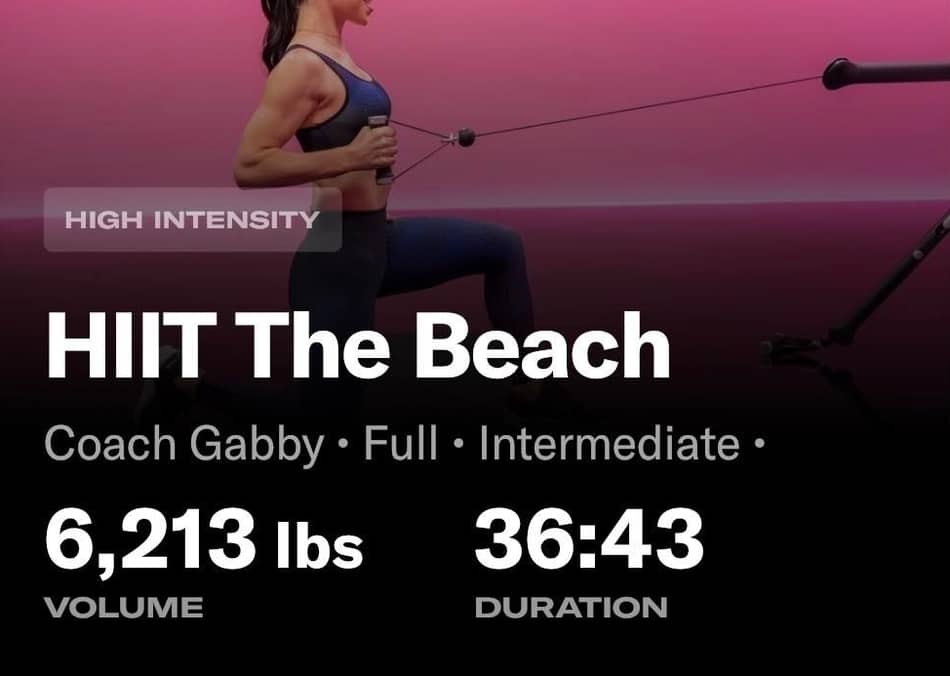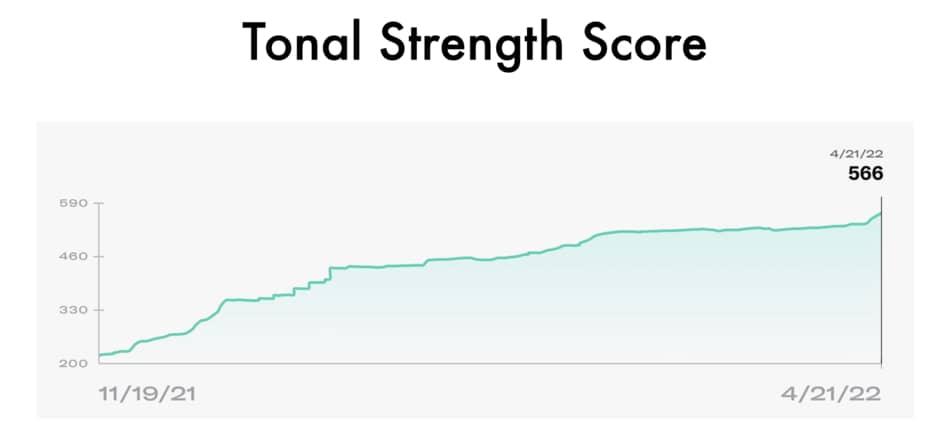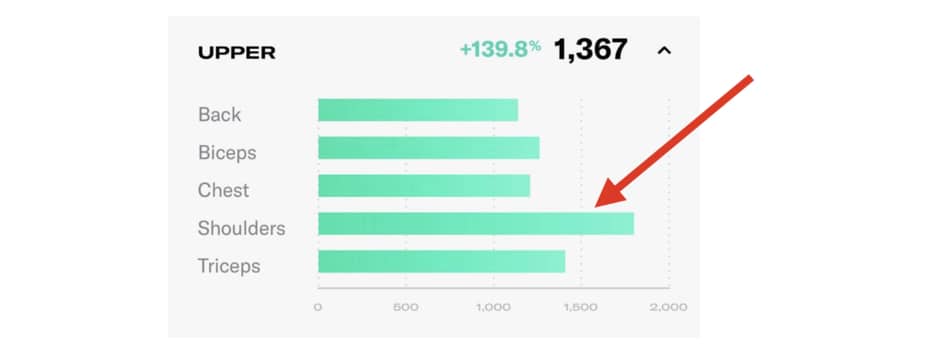If I had to pick one metric on Tonal that can help you stay focused on your goals, it would be a Strength Score.
Today I will explain what does Tonal strength score means, how it works, and how you can use it to burn fat and build muscle.

As a whole, the Tonal strength score is a personal and non-competitive metric system that measures your overall training load using advanced AI algorithms from your workout history and current performance. However, a Tonal Strength Score should not be used as a measure of how “strong” you are, but rather how much progress you make.
What is a Tonal strength score?
The Tonal strength score is a system that measures total body strength for most of the lifts.
It provides a comprehensive report where you can track your strength improvements from the previous months based on your resistance and repetitions.
Similar to wearable activity trackers, Tonal strength score help to keep track of your improvement, without having to do any calculations.
Traditionally, in the gym people who were serious about their strength and muscle gains would bring a notepad with a pen.
Why do I like the Tonal strength score?
Here is why I think tracking using Tonal strength score is awesome:
- Tracking let you write down your weekly workout programs.
- Tracking let you record your weight and reps.
- Tracking let you describe your RPE (rate of perceived exertion).
- Tracking let you record your progress.
That’s what I did with me and my clients.
(Yes, it’s old-school, but it works.)
A large meta-analysis from twenty-six studies has shown that “physical activity, gradually increasing intensity, creating detailed plans, receiving instructions, using prompts, and rewarding oneself for progress promote a change in physical activity behavior.”
Tonal goes one step further.
Tonal not only track your workouts, reps, sets, and resistance but also uses strength score to give you insights about where exactly you’re making the most progress (and where not), without you having to write down anything.
Is a high Tonal strength score important?
In general, a high strength score on Tonal is an important factor that shows you’re getting stronger, especially if building muscle and strength is your goal.
However, people who don’t use metrics and don’t track their performance should not worry about their strength scores.
For example, a Tonal strength score of 1000 does not mean someone is either strong or not (more on that later).
Here you can learn more about what are the best tonal workouts for fat loss and muscle mass.
How does the Tonal strength score work?
It works automatically after you create your account and complete your first workout. It takes into consideration your power output, resistance, and number of reps.
By the end of each workout, you receive a complete strength report.
Here’s how this process looks:
- Resistance training involves doing exercises against a load.
- To complete the loaded movement, the muscles need to produce tension and force.
- If the load is challenging enough, the muscles adapt by becoming capable of producing more tension.
That’s how you get stronger (conversely, if you don’t challenge your muscles they will adapt again by becoming less active and weaker).
What is a good tonal strength score?
On average, the good strength score on Tonal is between 350–600 for men, and the range for women is around 150–300.
A total strength score above these numbers places you above 90 percent of all Tonal members.
What is the max strength score?
There is no limit on the Tonal strength score, even if the machine has only 200lbs resistance.
Tonal strength score is calculated based on the weight, as well as on the number of repetitions you do and which dynamic modes you use.
The highest score I’ve seen was above 2500, which is realistic considering you’re using the machine meticulously.
What is the Tonal strength score overview?
The Tonal strength score overview is on the analytics report page. You can access it from the Tonal dashboard.
It includes not only the total strength score number but also the line graphs with historical progress, as well as the bar graphs with a detailed breakdown of each muscle group with a corresponding score.
Here’s w photo of my Tonal strength score between November 2021 to April 2022.

It starts from just above 200 and 5 months later I was on 566 (I don’t do much more work so it lowers my overall strength score).
I like this type of metric because it shows you the overall trend, which is really effective in increasing motivation, especially for beginners (more on that later).
Tonal shows which muscle works during the workout
Another cool feature in the Tonal strength score overview is the detailed breakdown of each muscle group. I like this metric because it can show you any “blind spots” or weak points in your programming.
For example, if you’re doing mainly lower body exercises that work on your anterior chain (quads) and not enough on the posterior chain (hamstrings or glutes) the Tonal strive score will show that.
How does Tonal calculate strength score?
Tonal calculates Strength Score from your historical and current exercises, mainly from the sets where you used the heaviest resistance (your PRs).
It also includes the number of workouts you did and the repetitions you used, but it does not include the number of sets.
For example, people who train 5 days a week will have a significantly higher strength score than people who train once a week.
In total, there are 14 strength scores on Tonal.
| Tonal Strength Score | How is calculated |
|---|---|
| Total Strength Score | The Total Strength Score is calculated from the weighted average of all muscle groups. |
| Upper Strength Score | The Upper Strength Score is calculated from the weighted average of all upper body muscle groups. It includes the back, biceps, chest, shoulders, and triceps. |
| Core Strength Score | The Core Strength Score is calculated from the weighted average of abs and obliques. |
| Lower Strength Score | The Lower Strength Score is calculated from the weighted average of glutes, hamstrings, and quads. |
NOTE: Tonal also includes Dynamic Modes like Eccentric Mode or Burnout Mode in the calculations. The more often you use these advanced training methods, your strength score will be higher.
One thing that I love about the Tonal strength score is it shows you exactly which muscles you work on the most, and which muscles you kind of neglect.
For example, in my case, I know I spend way too little time on my abs.
Keep in mind that the Tonal strength score is independent of things like body weight, age, gender, and height, which makes it unreliable to compare your score with others.
Also, please remember that there is a big difference between the Tonal strength score and training volume.
Tonal strength score and training volume
Tonal strength score and training volume (also called a training load) are not the same.
The difference between the Tonal strength score and training volume is that the strength score is calculated based on the best set of each movement in a workout.
This means you can do 1 or 5 sets of the given exercise (e.g. barbell squats) and your strength score won’t change.
A good way to increase your Tonal strength score is by using more resistance or doing more reps in one set.
For example, if your historical best bench press set was done with 100lbs for 10 reps, but now you did 12 reps or more, your strength score will go up.
I find this number to be useful especially if you want to look at your metrics per muscle group because it is a clear indicator of which areas you can improve and which areas you’re strong already.
On the other hand, training volume is the total amount of reps, sets, and resistance you used within a day, week, or month.
Progressively increasing your training volume enhances muscular adaptations and leads to increases in strength and muscle size.
Is the Tonal strength score level accurate?
In short, the Tonal strength score is accurate, but it’s not the complete metric to track your performance.
Tonal uses algorithms that establish your strength score based only on workouts.
It doesn’t take into consideration other factors like rest, sleep, nutrition, or injury.
How do I use the Tonal strength score?
Here are four main ways I use the Tonal strength score.
- Assessment tool – I use the Tonal strength score as a strength assessment tool. It provides me with clear information on your baseline fitness level.
- Progress tracker – Tonal strength score is a viable way to track my strength gains, together with other metrics like total training volume, streak score, and total weight lifted.
- Motivation tool – People who are driven by numbers can use the Strength Score to stay motivated and maintain their willingness to train, as long as the numbers go up.
- Competition – Tonal strength score includes a benchmark, which compares my numbers with other Tonal members.
- Establish fitness goals – Tonal strength score shows the differences between each muscle group, which helps to increase my awareness and make realistic and trackable goals.
NOTE: Focusing only on the Strength Score can also be counterproductive (in some cases) and actually reduce motivation to exercise, especially when the numbers go down.
In this case, is better to use other metrics like streak score.
For me, the best way to improve your strength score on Tonal is by implementing progressive overload, which means adding more reps and weight to your weekly workout plan over time.
My Tonal strength score experiment
One of the biggest disadvantages of the Tonal strength score is the way it calculates the numbers.
As I’ve mentioned before, Tonal takes the strength score based on the best set, not the training volume.
This is one of the drawbacks of the Tonal because you can do significantly more training volume on your upper body per week, but if you push more resistance on the lower body for only one day, the strength score will get higher.
I did a small experiment where I increased my total number of sets for the bench press up to 6 with a heavy load but I reduced the number of reps to 4 (I like this type of training because it helps to put on strength, without adding size).
The overall training volume for the chest is high because it gives me a total of 72 reps of bench press at 85% 1RM per week. The perfect way to build strength.
See below for details.
| Tonal full-body workout |
|---|
| Barbell Bench press (6 sets 4 reps) 85% 1RM Barbell Squats (3 sets 5 reps) 80% 1RM Barbell Deadlifts (3 sets 5 reps) 70-90% 1RM Overhead Press (3 sets 8 reps) 70-80% 1RM |
Here’s what’s interesting.
You can notice above that rest of my lifts remained unchanged, apart from the shoulder press. With my overhead press, I kept the same amount of sets (3 in total) but I added only a few more reps (8 in total).
The results?
See below.

As you can see above, just a couple of weeks following this routine with 8 reps on shoulder press was enough to increase my Tonal strength score.
At the same time, my chest strength score dropped after my bench press adjustment.
Let’s make no mistake. The bench press change drove my overall strength (not the strength score) through the roof, whereas the shoulder press stayed the same.
Conclusion
As you can see, the Tonal strength score is an excellent way not only to track your progress but also to assess your workout plan because you can monitor which body parts need more attention than others.
However, I personally think that the Tonal strength score should not be used as a goal in itself, but rather as one of many tools to help you reach your fitness goals.
